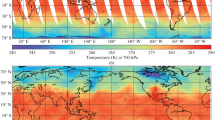Abstract
In this work, the possibility of retrieving the profile of absolute humidity of the atmosphere by means of an artificial neural network is investigated based on modeling radiometric data of the MIRS passive microwave complex, which is a part of the scientific equipment of the Convergence space experiment. The process of modeling MIRS radiometric data is described. Optimum characteristics of the neural network are selected. The necessity of information about the atmospheric temperature profile for the best accuracy in solving the inverse problem is shown. The advantages of using “differential” channels in the 22-GHz absorption band for retrieving the humidity profile are demonstrated. The expected errors in retrieving the atmospheric humidity profile in the course of the Convergence space experiment at heights from 0 to 10 km are presented.









Similar content being viewed by others
REFERENCES
Blackwell, W.J., A neural-network technique for the retrieval of atmospheric temperature and moisture profiles from high spectral resolution sounding data, IEEE Trans. Geosci. Remote Sens., 2005, vol. 43, no. 11, pp. 2535–2546.
Clatchey, R.A., Fenn, R.W., Selby, J.E.A., Garing, J.S., and Volz, F.E., Optical Properties of the Atmosphere, 3rd Ed., Bedford, MA: AFCRL, 1972, p. 108.
Climate change 2014: Synthesis report. IPCC, 2015. http:// www.ipcc.ch/pdf/assessment-report/ar5/syr/SYR_AR5_ FINAL_full_ru.pdf (accessed 30 October 2017).
Dee, D.P., et al., The ERA-Interim reanalysis: configuration and performance of the data assimilation system, Q. J. R. Meteorol. Soc., 2011, no. 137, pp. 553–597.
Ermakov, D.M., Sharkov, E.A., and Chernushich, A.P., The role of tropospheric advection of latent heat in the intensification of tropical cyclones, Issled. Zemli Kosmosa, 2014, no. 4, pp. 3–15.
Gohil, B.S. and Mathur, A.K., Atmospheric humidity profile retrieval algorithms for Megha-Tropiques SAPHIR: a simulation study and analysis of AMSU-B data, Proc. SPIE, 2006, vol. 6408, pp. 640803-1–640803-9.
Haykin, S., Neironnye seti. Polnyi kurs (Neural Networks. A Comprehensive Foundation), Moscow: Williams, 2016.
Kruglov, V.V. and Borisov, V.V., Iskusstvennye neyronnye seti. Teoriya i praktika (Artificial Neural Networks. Theory and Practice), Moscow: Goryachaya liniya–Telecom, 2002.
Kutuza, B.G., Danilichev, M.V., and Yakovlev, O.I., Sputnikovyi monitoring Zemli: Mikrovolnovaya radiometriya atmosfery i poverkhnosti (Satellite Earth Monitoring. Microwave Radiometry of Atmosphere and Surface), Moscow: LENALAND, 2016.
Meissner, T. and Wentz, F.J., The emissivity of the ocean surface between 6 and 90 GHz over a large range of wind speeds and Earth incidence angles, IEEE Trans. Geosci. Remote Sens., 2012, vol. 50, no. 8, pp. 3004–3026.
Di Paola, F.D., Ricciardelli, E., Cimini, D., Cersosimo, A., Paola, A.D., Gallucci, D., Gentile, S., Geraldi, E., Larosa, S., Nilo, S.T., Ripepi, E., Romano, F., Sano, P., and Viggiano, M., MiRTaW: an algorithm for atmospheric temperature and water vapor profile estimation from ATMS measurements using a random forests technique, Remote Sens., 2018, no. 10, p. 1398.
Polyakov, A.V., Timofeev, Yu.M., and Virolainen, Ya.A., Using artificial neural networks in the temperature and humidity sounding of the atmosphere, Izv., Atmos. Oceanic Phys., 2014, vol. 50, no. 3, pp. 373–380.
Rosenkranz, P.W., Water vapor microwave continuum absorption: a comparison of measurements and models, Radio Sci., 1998, no. 33(4), pp. 919–928.
Savorskiy, V.P., Akvilonova, A.B., Ermakov, D.M., Kibardina, I.N., Panova, O.Yu., Smirnov, M.T., Turygin, S.Y., and Chernushich, A.P., Simulation of satellite microwave radiometric information used to reconstruct three-dimensional fields of atmospheric parameters, Sovr. Probl. Dist. Zond. Zemli Kosmosa, 2018, vol. 15, no. 2, pp. 235–250.
Sharkov, E.A., Radioteplovoe distantsionnoe zondirovanie Zemli: fizicheskie osnovy. T. 1 (Radiothermal Remote Sensing of the Earth: Physical Foundations. Vol. 1), Moscow: IKI RAN, 2014.
Sharkov, E.A., Remote sensing of atmospheric catastrophes, Issled. Zemli Kosmosa, 2010, no. 1, pp. 52–68.
Sharkov, E.A., Kuzmin, A.V., Vedenkin, N.N., Jeong, S., Ermakov, D.M., Kvitka, V.E., Kozlova, T.O., Komarova, N.Yu., Minaev, P.Yu., Park, Il.H., Pashinov, E.V., Pozanenko, A.S., Prasolov, V.O., Sadovsky, I.N., Sazonov, D.S., Sterlyadkin, V.V., Khapin, Yu.B., Hong, G., and Chernenko, A.M., The Konvergentsiya space experiment: scientific objectives, on-board equipment, methods of reverse problem solving, Issled. Zemli Kosmosa, 2018, no. 4, pp. 71–96.
Sterlyadkin, V.V. and Sharkov, E.A., Differential radiothermal methods for determining the vertical profile of water vapor in the troposphere and stratosphere of the Earth, Issled. Zemli Kosmosa, 2014, no. 5, pp. 15–28.
Sterlyadkin, V.V., Pashinov, E.V., Kuzmin, A.V., and Sharkov, E.A., Differential radiothermal methods for reconstructing the atmospheric moisture profile from spacecraft, Issled. Zemli Kosmosa, 2017, no. 2, pp. 64–76.
Tikhonov, A.N. and Arsenin, V.Ya., Metody resheniya nekorrektnykh zadach (Methods for Solving Ill-Posed Problems), Moscow: Nauka, 1974, p. 224.
Weng, F. and Zou, X., Introduction to Suomi national polar orbiting partnership advanced technology microwave sounder for numerical weather prediction and tropical cyclone applications, J. Geophys. Res., 2012, vol. 117, pp. 2156–2202.
ACKNOWLEDGMENTS
I am grateful to V.V. Sterlyadkin and E.A. Sharkov for their participation in the discussion of the results.
Funding
This work was supported by the Russian Foundation for Basic Research, project no. 18-02-01009 A.
Author information
Authors and Affiliations
Corresponding author
Additional information
Translated by A. Nikol’skii
Rights and permissions
About this article
Cite this article
Pashinov, E.V. Convergence Space Experiment: Retrieving the Water-Vapor Profile of the Atmosphere by Means of Artificial Neural Networks. Izv. Atmos. Ocean. Phys. 56, 898–908 (2020). https://doi.org/10.1134/S0001433820090194
Received:
Revised:
Accepted:
Published:
Issue Date:
DOI: https://doi.org/10.1134/S0001433820090194




